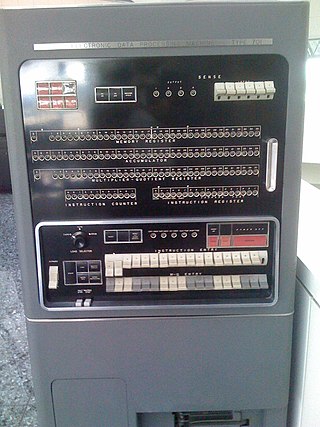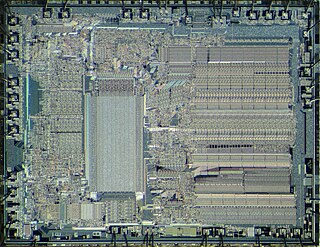Direct memory access (DMA) is a feature of computer systems that allows certain hardware subsystems to access main system memory independently of the central processing unit (CPU).

The CDC 6600 was the flagship of the 6000 series of mainframe computer systems manufactured by Control Data Corporation. Generally considered to be the first successful supercomputer, it outperformed the industry's prior recordholder, the IBM 7030 Stretch, by a factor of three. With performance of up to three megaFLOPS, the CDC 6600 was the world's fastest computer from 1964 to 1969, when it relinquished that status to its successor, the CDC 7600.

The IBM 650 Magnetic Drum Data-Processing Machine is an early digital computer produced by IBM in the mid-1950s. It was the first mass-produced computer in the world. Almost 2,000 systems were produced, the last in 1962, and it was the first computer to make a meaningful profit. The first one was installed in late 1954 and it was the most popular computer of the 1950s.

UNIVAC was a line of electronic digital stored-program computers starting with the products of the Eckert–Mauchly Computer Corporation. Later the name was applied to a division of the Remington Rand company and successor organizations.

The IBM 7030, also known as Stretch, was IBM's first transistorized supercomputer. It was the fastest computer in the world from 1961 until the first CDC 6600 became operational in 1964.

The IBM 701 Electronic Data Processing Machine, known as the Defense Calculator while in development, was IBM’s first commercial scientific computer and its first series production mainframe computer, which was announced to the public on May 21, 1952. It was designed and developed by Jerrier Haddad and Nathaniel Rochester and was based on the IAS machine at Princeton.

The UNIVAC 1100/2200 series is a series of compatible 36-bit computer systems, beginning with the UNIVAC 1107 in 1962, initially made by Sperry Rand. The series continues to be supported today by Unisys Corporation as the ClearPath Dorado Series. The solid-state 1107 model number was in the same sequence as the earlier vacuum-tube computers, but the early computers were not compatible with their solid-state successors.

The IBM 700/7000 series is a series of large-scale (mainframe) computer systems that were made by IBM through the 1950s and early 1960s. The series includes several different, incompatible processor architectures. The 700s use vacuum-tube logic and were made obsolete by the introduction of the transistorized 7000s. The 7000s, in turn, were eventually replaced with System/360, which was announced in 1964. However the 360/65, the first 360 powerful enough to replace 7000s, did not become available until November 1965. Early problems with OS/360 and the high cost of converting software kept many 7000s in service for years afterward.

The HP 2100 is a series of 16-bit minicomputers that were produced by Hewlett-Packard (HP) from the mid-1960s to early 1990s. Tens of thousands of machines in the series were sold over its twenty-five year lifetime, making HP the fourth largest minicomputer vendor during the 1970s.

The Intel 8087, announced in 1980, was the first floating-point coprocessor for the 8086 line of microprocessors. The purpose of the chip was to speed up floating-point arithmetic operations, such as addition, subtraction, multiplication, division, and square root. It also computes transcendental functions such as exponential, logarithmic or trigonometric calculations. The performance enhancements were from approximately 20% to over 500%, depending on the specific application. The 8087 could perform about 50,000 FLOPS using around 2.4 watts.
KDF9 was an early British 48-bit computer designed and built by English Electric. The first machine came into service in 1964 and the last of 29 machines was decommissioned in 1980 at the National Physical Laboratory. The KDF9 was designed for, and used almost entirely in, the mathematical and scientific processing fields – in 1967, nine were in use in UK universities and technical colleges. The KDF8, developed in parallel, was aimed at commercial processing workloads.
In computing, a word is the natural unit of data used by a particular processor design. A word is a fixed-sized datum handled as a unit by the instruction set or the hardware of the processor. The number of bits or digits in a word is an important characteristic of any specific processor design or computer architecture.
In computing, channel I/O is a high-performance input/output (I/O) architecture that is implemented in various forms on a number of computer architectures, especially on mainframe computers. In the past, channels were generally implemented with custom devices, variously named channel, I/O processor, I/O controller, I/O synchronizer, or DMA controller.
In computing, traditionally cycle stealing is a method of accessing computer memory (RAM) or bus without interfering with the CPU. It is similar to direct memory access (DMA) for allowing I/O controllers to read or write RAM without CPU intervention. Clever exploitation of specific CPU or bus timings can permit the CPU to run at full speed without any delay if external devices access memory not actively participating in the CPU's current activity and complete the operations before any possible CPU conflict.

The CDC 6000 series is a discontinued family of mainframe computers manufactured by Control Data Corporation in the 1960s. It consisted of the CDC 6200, CDC 6300, CDC 6400, CDC 6500, CDC 6600 and CDC 6700 computers, which were all extremely rapid and efficient for their time. Each is a large, solid-state, general-purpose, digital computer that performs scientific and business data processing as well as multiprogramming, multiprocessing, Remote Job Entry, time-sharing, and data management tasks under the control of the operating system called SCOPE. By 1970 there also was a time-sharing oriented operating system named KRONOS. They were part of the first generation of supercomputers. The 6600 was the flagship of Control Data's 6000 series.

The CDC 160 series was a series of minicomputers built by Control Data Corporation. The CDC 160 and CDC 160-A were 12-bit minicomputers built from 1960 to 1965; the CDC 160G was a 13-bit minicomputer, with an extended version of the CDC 160-A instruction set, and a compatibility mode in which it did not use the 13th bit. The 160 was designed by Seymour Cray - reportedly over a long three-day weekend. It fit into the desk where its operator sat.

The history of general-purpose CPUs is a continuation of the earlier history of computing hardware.

The RCA Spectra 70 is a line of electronic data processing (EDP) equipment that was manufactured by the Radio Corporation of America’s computer division beginning in April 1965. The Spectra 70 line included several CPU models, various configurations of core memory, mass-storage devices, terminal equipment, and a variety of specialized interface equipment.

A vacuum-tube computer, now termed a first-generation computer, is a computer that uses vacuum tubes for logic circuitry. While the history of mechanical aids to computation goes back centuries, if not millennia, the history of vacuum tube computers is confined to the middle of the 20th century. Lee De Forest invented the triode in 1906. The first example of using vacuum tubes for computation, the Atanasoff–Berry computer, was demonstrated in 1939. Vacuum-tube computers were initially one-of-a-kind designs, but commercial models were introduced in the 1950s and sold in volumes ranging from single digits to thousands of units. By the early 1960s vacuum tube computers were obsolete, superseded by second-generation transistorized computers.
Philco was one of the pioneers of transistorized computers. After the company developed the surface barrier transistor, which was much faster than previous point-contact types, it was awarded contracts for military and government computers. Commercialized derivatives of some of these designs became successful business and scientific computers. The TRANSAC Model S-1000 was released as a scientific computer. The TRANSAC S-2000 mainframe computer system was first produced in 1958, and a family of compatible machines, with increasing performance, was released over the next several years.















